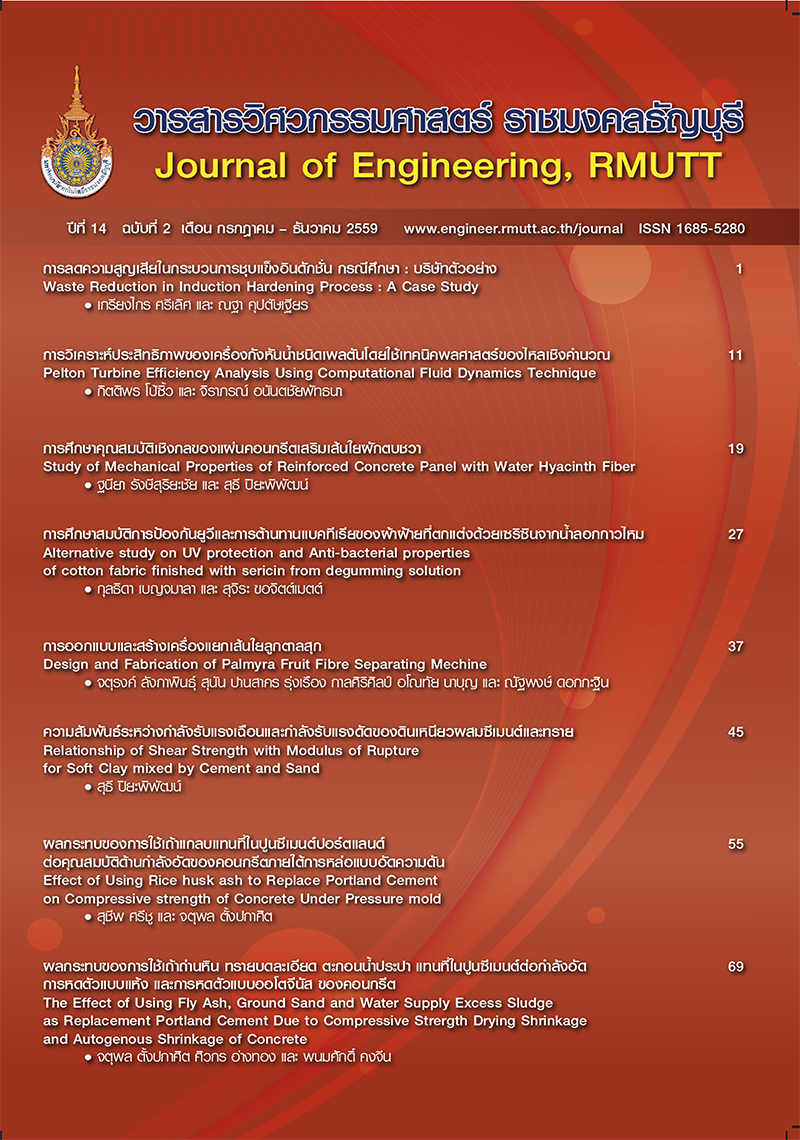The Effect of Using Fly Ash, Ground Sand and Water Supply Excess Sludge as Replacement Portland Cement Due to Compressive Strergth Drying Shrinkage and Autogenous Shrinkage of Concrete
Main Article Content
Abstract
The using of replacement materials in Portland cement is used by-product from industrial to reduce environment problem. It can be improved quality and reduce cost of concrete. But shrinkage of concrete is main effect on durability. This research is study the effect of using fly ash, ground sand and water supply excess sludge with the same particle size as Portland cement was replaced by replacement materials at the rate of 10 and 20% by weight of binder. The compressive strength of 15 x 15 x 15 cm. concrete cubes were determined at the age of 7, 14, 28, and 60 days. The concrete specimen of 7.5 x 7.5 x 28.5 cm. is used for drying shrinkage and autogenus shrinkage with air, water and plastic sheet curing
The results showed that the compressive strength of fly ash concrete is lower than normal concrete at early age but it can be higher than normal concrete at the age of 60 days. The compressive strength of ground sand concrete and water supply excess sludge concrete are lower than normal concrete at all ages. At early age the compressive strength of water supply excess sludge concrete is higher than ground sand concrete. Drying shrinkage and autogenus shrinkage of fly ash concrete is less than ground sand concrete and water supply excess sludge concrete. At the rate of replacement 20% of fly ash concrete is lowest drying shrinkage and autogenus shrinkage. The curing under water is the lowest shrinkage.
Article Details
The manuscript, information, content, picture and so forth which were published on Frontiers in engineering innovation research has been a copyright of this journal only. There is not allow anyone or any organize to duplicate all content or some document for unethical publication.
References
ศ.ดร.ปริญญา จินตประเสริฐ, ศ.ดร.ชัย จาตุรพิทักษ์กุล. (2547). ปูนซีเมนต์ปอซโซลานและคอนกรีต. กรุงเทพฯ : สมาคมคอนกรีตไทย (ส.ค.ท.) วิศวกรรมสถานแห่งชาติ.
นายจิตรกร วงศ์กรชวลิต. (2544). คุณสมบัติทางเคมีของเถ้าตะกอนสลัดที่เกิดจากการผลิตน้ำประปา และนำไปใช้ในงาน. วิทยานิพนธ์วิศวกรรมศาสตร์ บัณฑิตวิทยาลัย. มหาวิทยาลัยเทคโนโลยีพระจอมเกล้าธนบุรี.
นายจตุพล ตั้งปกาศิต และคณะ. (2549). กำลังอัดของอนุภาคต่อค่าดัชนีกำลังของมอร์ต้าร์ ตามมาตรฐาน ASTM C618 โดยใช้ทรายแม่น้ำบดละเอียด. วารสารวิจัยและพัฒนา. มหาวิทยาลัยเทคโนโลยีพระจอมเกล้าธนบุรี.
American Society for Testing and Material, Annual Book of ASTM C596 Standard, V 04.02, Easton, Md., USA., 2001.
American Sociedy for Testing and Material, Annual Book of ASTM C33 Standard, V 04.02, Easton, Md., USA., 2001.
[6] ผศ.ดร.ปิติศานต์ กร้ามาตร. (2553). คุณสมบัติเบื้องต้นของคอนกรีตผสมเถ้าถ่านหินและผงหินปูน. วิทยานิพนธ์วิศวกรรมศาสตร์. มหาวิทยาลัยเทคโนโลยีราชมงคลธัญบุรี.
Jatuphon Tangpagasit, Raungrut, Cheerarot, Chai Jaturapitakkul, Kraiwood Kiattikowmol, Packing effect and Pozzolanic reaction of fly ash in mottar., Cement and Conctete Research 35 (2005) 1145-1151.


